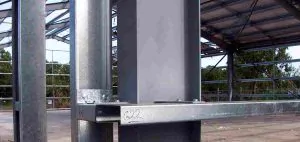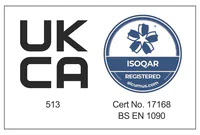
Universal Steel Columns
Universal columns are similar in appearance to universal beams, but typically have a wider flange or fillet. 
Universal columns are structural steel columns used in a vertical position. Their I-shaped cross-section is similar to that of universal beams, but a steel column flange is usually wider than that of a beam.
There are several elements that combine to define universal column sizes. This includes the depth and width of the steel section, the thickness of its web and flanges, the root radius and the depth between the fillets.
For full details of all the universal column sizes we supply, please consult our universal column table, which specifies characteristics like plastic modulus, elastic modulus, torsional index and more.
What is a steel column?
A steel support column is normally positioned vertically, for example to reinforce a concrete pillar, or to support a ceiling or upper storey.
The cross-section of universal columns is shaped like a capital I or H, with several key characteristics:
- The central span of the cross-section is the web
- Each of the four ‘wings’ at right-angles to this span is a flange
- Each pair of flanges (forming a T-shape with the web) is a fillet
Knowing these basic 2-3 elements gives rise to a number of parameters when specifying universal steel columns:
- h is the depth of the section (the full height of the I-shape including the fillets)
- b is the width of the section (the full width across the tips of the flanges)
- s is the thickness of the web (the central span that connects the fillets)
- t is the thickness of the flanges (measured across the flat section of the flange)
- r is the root radius (the inner curve of the right angle where the flanges join the web)
- d is the depth between fillets (the depth of the section minus the thickness of the flanges)
All of these parameters come into play when calculating universal column sizes. Our handy universal column table shows what’s available, along with some practical values like the cross-sectional area and the mass per metre.
How thick do steel columns need to be?
The ‘thickness’ of a steel column can be defined in various ways, such as the thickness of the web and fillets, the width or depth of the section, and even the effect of the root radius.
Because of this, calculating exactly how thick steel columns need to be depends on the specific application for which the universal column will be used.
In general, a larger cross-sectional area (referred to as the ‘footprint’ of the steel column) is associated with thicker web and fillets, and will therefore lead to a higher mass per metre and greater strength.
Our structural steel columns range in size from 152.4 x 152.2 mm and a mass of 23.0 kg per metre, up to 474.6 x 424.0 mm and a mass of 633.9 kg per metre.
What size are structural steel columns?
The footprint of the column dictates its size in terms of the area of land it will occupy. Because structural steel columns are typically perfectly vertical, the column will usually stand perfectly over this footprint, without taking up any more space.
Combined with the recesses between the fillets and the web, this can give universal steel columns a surprisingly minimal profile in use, even when installed as a free-standing column to support a platform or mezzanine.
In many cases, structural steel columns are used purposefully as part of an industrial interior design scheme, with the intention of being left visible, rather than being boxed in or otherwise disguised.
The height of the column (that is, the measurement perpendicular to the cross-sectional area) will depend on what the column is supporting, and will have a direct impact on the total weight of the steel section.
Calculating the total weight is simply a case of determining the height of the column and multiplying by the specified mass per metre, to give a total mass in kg.
Again, all of these characteristics can be found in our downloadable steel column table, providing a handy guide to calculate mass and footprint, and as a reference when placing an order.
Are steel columns stronger than concrete?
Structural steel columns are very strong. As an alloy, steel is much stronger than the iron from which it is made, and the shape of a universal column’s cross-section helps to reinforce it against bending and warping.
For a load-bearing column, compressive strength is important. Steel columns can typically withstand loads of around 36,000 psi (250 MPa).
In contrast, concrete alone is relatively weak under compression forces, at around 4,000 psi (27.5 kPa). That is unless it is reinforced – which is normally done using steel.
Recycled steel suffers no loss in quality, allowing recycled steel columns to provide just as much strength as those made of virgin steel.
Because of this, steel is a truly sustainable construction material – allowing strong structures to be built time and time again, versus concrete which is essentially a single-use mineral for such applications.


